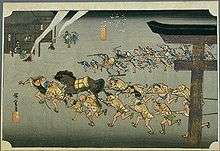Miya-juku

Miya-juku (宮宿 Miya-juku) was the forty-first of the fifty-three stations of the Tōkaidō. It is located in former Owari Province in what is now part of the Atsuta-ku section of the city of Nagoya, in Aichi Prefecture, Japan. It was six km from Narumi-juku, the preceding post station.[1]
History
In addition to being a post station on the Tōkaidō, Miya-juku was also part of the Minoji (a minor route which runs to Tarui-juku on the Nakasendō) and the Saya Kaidō. As a result, it had the most hatago of any post station along the Tōkaidō, with two honjin, one wakihonjin and 248 lesser inns.
The classic ukiyoe print by Ando Hiroshige (Hoeido edition) from 1831 to 1834 depicts two gangs of men dragging a portable shrine cart (not shown) past a huge torii gate. The torii gate is the symbol of a Shinto shrine, and the name of "Miya" also means a "Shinto shrine". The shrine in question is the famous Atsuta Shrine, one of the most famous in Japan and a popular pilgrimage destination in the Edo period. [2] The area is now part of downtown Nagoya metropolis.
Neighboring post towns
- Tōkaidō
- Narumi-juku - Miya-juku - Kuwana-juku
- Saya Kaidō
- Miya-juku (starting location) - Iwazuka-juku
- Minoji
- Miya-juku (starting location) - Nagoya-juku
Further reading
- Carey, Patrick. Rediscovering the Old Tokaido:In the Footsteps of Hiroshige. Global Books UK (2000). ISBN 1-901903-10-9
- Chiba, Reiko. Hiroshige's Tokaido in Prints and Poetry. Tuttle. (1982) ISBN 0-8048-0246-7
- Taganau, Jilly. The Tokaido Road: Travelling and Representation in Edo and Meiji Japan. RoutledgeCurzon (2004). ISBN 0-415-31091-1
References
| Wikimedia Commons has media related to Miya-juku. |
- ↑ Tokaido 53: Miya-juku (Nagoya). (Japanese) Tōkaidō no Tabi. Accessed March 7, 2008.
- ↑ http://www.hiroshige.org.uk/hiroshige/tokaido_hoeido/tokaido_hoeido_05.htm
Coordinates: 35°07′44″N 136°54′51″E / 35.1289°N 136.9143°E
